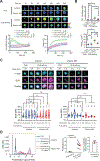B cell responses to membrane-presented antigens require the function of the mechanosensitive cation channel Piezo1
- PMID: 37751477
- PMCID: PMC10691204
- DOI: 10.1126/scisignal.abq5096
B cell responses to membrane-presented antigens require the function of the mechanosensitive cation channel Piezo1
Abstract
The demand for a vaccine for coronavirus disease 2019 (COVID-19) highlighted gaps in our understanding of the requirements for B cell responses to antigens, particularly to membrane-presented antigens, as occurs in vivo. We found that human B cell responses to membrane-presented antigens required the function of Piezo1, a plasma membrane mechanosensitive cation channel. Simply making contact with a glass probe induced calcium (Ca2+) fluxes in B cells that were blocked by the Piezo1 inhibitor GsMTx4. When placed on glass surfaces, the plasma membrane tension of B cells increased, which stimulated Ca2+ influx and spreading of B cells over the glass surface, which was blocked by the Piezo1 inhibitor OB-1. B cell responses to membrane-presented antigens but not to soluble antigens were inhibited both by Piezo1 inhibitors and by siRNA-mediated knockdown of Piezo1. Thus, the activation of Piezo1 defines an essential event in B cell activation to membrane-presented antigens that may be exploited to improve the efficacy of vaccines.
Conflict of interest statement
Figures






Similar articles
-
Mechanosensitive cation currents through TRPC6 and Piezo1 channels in human pulmonary arterial endothelial cells.Am J Physiol Cell Physiol. 2022 Oct 1;323(4):C959-C973. doi: 10.1152/ajpcell.00313.2022. Epub 2022 Aug 15. Am J Physiol Cell Physiol. 2022. PMID: 35968892 Free PMC article.
-
The Mechanosensitive Ion Channel PIEZO1 in Intestinal Epithelial Cells Mediates Inflammation through the NOD-Like Receptor 3 Pathway in Crohn's Disease.Inflamm Bowel Dis. 2023 Jan 5;29(1):103-115. doi: 10.1093/ibd/izac152. Inflamm Bowel Dis. 2023. PMID: 35907203
-
GsMTx4-blocked PIEZO1 channel promotes myogenic differentiation and alleviates myofiber damage in Duchenne muscular dystrophy.Skelet Muscle. 2025 May 14;15(1):13. doi: 10.1186/s13395-025-00383-5. Skelet Muscle. 2025. PMID: 40361216 Free PMC article.
-
Mechanosensitive Cation Channel Piezo1 Is Involved in Renal Fibrosis Induction.Int J Mol Sci. 2024 Jan 31;25(3):1718. doi: 10.3390/ijms25031718. Int J Mol Sci. 2024. PMID: 38338996 Free PMC article. Review.
-
Piezo1: properties of a cation selective mechanical channel.Channels (Austin). 2012 Jul-Aug;6(4):214-9. doi: 10.4161/chan.21050. Epub 2012 Jul 1. Channels (Austin). 2012. PMID: 22790400 Free PMC article. Review.
Cited by
-
Role of mechanosensitive channel Piezo1 protein in intestinal inflammation regulation: A potential target.FASEB J. 2024 Oct 31;38(20):e70122. doi: 10.1096/fj.202401323R. FASEB J. 2024. PMID: 39425504 Free PMC article. Review.
-
Replication-incompetent VSV-based vaccine elicits protective responses against SARS-CoV-2 and influenza virus.Sci Adv. 2025 Jan 31;11(5):eadq4545. doi: 10.1126/sciadv.adq4545. Epub 2025 Jan 29. Sci Adv. 2025. PMID: 39879304 Free PMC article.
-
Both sides now: evolutionary traits of antigens and B cells in tolerance and activation.Front Immunol. 2024 Aug 9;15:1456220. doi: 10.3389/fimmu.2024.1456220. eCollection 2024. Front Immunol. 2024. PMID: 39185403 Free PMC article. Review.
-
Circular mRNA-LNP vaccine encoding self-assembled E2-TMD-mi3 nanoparticles licit enhanced CSFV-specific immunity over commercial subunit vaccine.Front Immunol. 2025 Jun 19;16:1604677. doi: 10.3389/fimmu.2025.1604677. eCollection 2025. Front Immunol. 2025. PMID: 40612955 Free PMC article.
-
Measuring Piezo1 and Actin Polarity in Chemokine-Stimulated Jurkat Cells During Live-Cell Imaging.Bio Protoc. 2024 Oct 5;14(19):e5079. doi: 10.21769/BioProtoc.5079. eCollection 2024 Oct 5. Bio Protoc. 2024. PMID: 39399591 Free PMC article.
References
-
- Kwak K, Akkaya M, Pierce SK, B cell signaling in context. Nat Immunol 20, 963–969 (2019). - PubMed
-
- Kurosaki T, Shinohara H, Baba Y, B cell signaling and fate decision. Annu Rev Immunol 28, 21–55 (2010). - PubMed
-
- Batista FD, Harwood NE, The who, how and where of antigen presentation to B cells. Nat Rev Immunol 9, 15–27 (2009). - PubMed
Publication types
MeSH terms
Substances
Grants and funding
LinkOut - more resources
Full Text Sources
Medical
Miscellaneous

